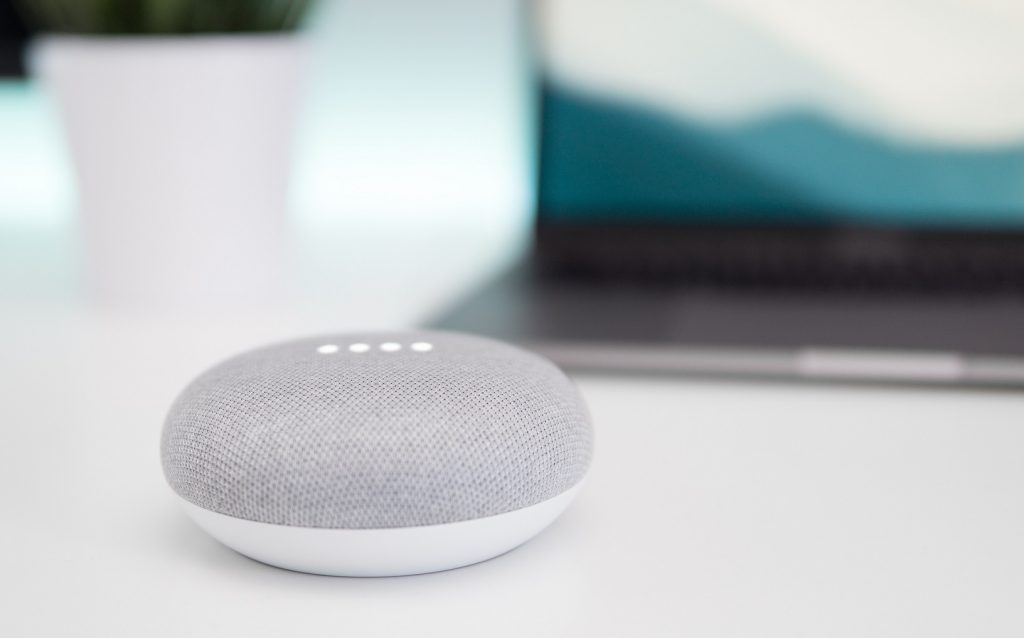Voice search is becoming increasingly important for webmasters, SEOs and online editors. In collaboration with Google, Schema.org developed the markup “speakable”. It’s basically a text-to-speech conversion that allows Google’s Assistant to read aloud marked content of a website.
More and more people are using their smartphones or smart speakers such as Amazon’s Alexa or Google’s Home devices to conveniently access information via voice search. They ask real questions. The spectrum ranges from questions about the weather, news, recipes, instructions and directions to product information. So far, verbal search results on news were limited to short summaries. Not anymore. Schema.org and Google came up with a real answer: Speakable. The markup enables Google’s Assistant to verbally respond marked content by converting text to speech. Editors can use the speakable structured data to indicate content that they feel is most suitable to be read aloud.

Speakable is currently being tested for US Google News
When a user asks Google Assistant “Hey Google, what are the news about Voice Search”, it searches the web for results, reads out a marked section of a relevant news article and names the news organization. At the same time, the Assistant sends the source and two other reports on the requested topic to the user’s mobile device.
Speakable is currently available for valid US news sites and english content only. As stated on Google Developers:
“The speakable property works for users in the U.S. that have Google Home devices set to English, and publishers that publish content in English. We hope to launch in other countries and languages as soon as sufficient number of publishers have implemented speakable.”
What’s behind the Schema.org markup Speakable?
The markup is live on Google Developers but still in beta and therefore subject to change. Google states: “We are currently developing this feature, so there may be changes in requirements or policies.”
Structured data for Speakable is also listed on Schema.org. For websites or in articles, the speakable specification is defined as:
“Indicates sections of a Web page that are particularly ‘speakable’ in the sense of being highlighted as being especially appropriate for text-to-speech conversion. Other sections of a page may also be usefully spoken in particular circumstances; the ‘speakable’ property serves to indicate the parts most likely to be generally useful for speech.”
Technical implementation of Speakable
You can currently implement the Schema.org markup speakable as HTML and JSON-LD. Microdata and RDFa will be available soon. For HTML, you can use the Google structured data testing tool.
Speakable structured data in HTML
<code><html>
<head>
<title>Technical implementation of Speakable
<meta name="description" content="You can currently implement the Schema.org
markup speakable as HTML and JSON-LD. Microdata and RDFa will be available soon.
For HTML, you can use the Google structured data testing tool"/>
<script type="application/ld+json">
{
"@context": "https://schema.org",
"@type": "WebPage",
"name": "Speakable Content",
"speakable":
{
"@type": "SpeakableSpecification",
"xpath": [
"/html/head/title",
"/html/head/meta[@name='description']/@content"
]
},
"url": "https://www.xovi.de/2018/08/speakable-structured-data/"
}
</script>
</head>
</html></code>
Speakable structured data in JSON-LD

You can already mark your content as speakable. Be aware, however, that the feature is currently being tested in the U.S. and for news services only. Nevertheless, the structured data may help you to get a featured snippet for search queries. If and how effective the speakable markup is for featured snippets, is difficult to assess.
Speakable Content: How to select readable content
There are some things you should take into account when using the speakable structured data. Basically: Think about the user intent and user behavior. They ask a question and expect an appropriate and meaningful response that doesn’t take too much time. Speakable content should also be snackable content: easy to listen to and delivered quickly.
- Less is more: Instead of marking an entire article as speakable, you should concentrate on important sections.
- Make your headlines as concise as possible.
- Use short sentences for your content. Short sentences are easy to read out for text-to-speech applications. For the listener, these short sentence structures are also easier to understand than long sentences with a complicated structure and complex content, which demand a high level of concentration from the listener and are also unlikely to be identified as a suitable search result by the Assistant.
- When marking content as speakable, make sure that it makes sense to read aloud. Do not use the structured data e.g. for datelines (in news or press releases), captions or references.
- Do not refer to content that cannot be read aloud (e.g. graphics) in the content selected for Speakable.
- Users’ attention span is short. This also applies to speakable content. The contents marked for structured data should not exceed 2 to 3 sentences or 20 to 30 seconds reading time.
Why speakable will be important for SEO
Voice search – and thus language-based search results and content – will make up a significant proportion of search queries. Smart Assistants such as Google Home devices or Amazon’s Alexa are on the rise. Voice search is already increasingly being used for mobile, with a high proportion of local search queries. A look at various statistics shows, for example, that “50% of all searches will be voice searches by 2020” and “about 30% of all searches will be done without a screen”.
Saban Denis Dasign, CEO of TRENDOMEDIA and XOVI Expert, assesses the importance of voice search for SEO in his article Speak Up! Is Voice Search Set to Replace Text Search? He says:
“In order to be found with direct answers in Google’s index, SEO experts must ensure that a website’s content provides immediate, accurate answers to specific questions.”
Speakable is just another natural development of voice search. And it will continue to evolve, especially with so many devices around: Don’t underestimate the widespread and steadily growing reach of Google’s Assistant. It’s everywhere. According to Google, in 2017 the Assistant was already “available on more than 400 million devices, including speakers like Google Home, Android phones and tablets, iPhones, headphones, TVs, watches and more.” This, more than 400 million devices can (and most likely will) make use of the speakable structured data.
With the Schema.org markup speakable, the accessibility of speech-based information will grow. Consequently, smart assistants will become increasingly relevant to people’s lives. Speakable is currently limited to U.S. news services. Currently. Once the beta phase is complete, the markup will surely be extended to numerous other search queries, languages and countries. For speech search results, the content that is best prepared in terms of content and technology will be given preference.
Prepare your content well. Start now. Do it not only for readers, but also for future listeners. Use the test phase to observe the development of the speakable markup and adapt your own content for text to speech conversion. Stay relevant in the coming time of voice search.
 English
English


